BluVirtu BAT-01 and Bluetooth BSH-01 Communication System
The BAT-01 is a battery powered Bluetooth hub or control module that allows up to four peripheral devices to be connected to provide audio input and output capabilities via a common audio channel. Outgoing communications are controlled by a PTT switch. Audio output is provided via Bluetooth to a compatible headset, such as the BSH-01.
The BSH-01 is a Bluetooth headset that supports the A2DP protocol, providing stereo audio streamed via Bluetooth from another A2DP device. The headset supports multiple Bluetooth partnerships and allows three connections to be maintained on a priority basis or as manually selected by the user.
Both components offer unique functional features that set them apart from many current offerings, including far more expensive systems. The BAT-01 device by itself is extremely compact and truly portable and when paired to a Bluetooth headset, very versatile.
All other features considered, having that exhilarating stereo stream reproduced by a quality set of high-fidelity speakers inside the helmet is a most convincing argument for considering the BSH-01 headset.
Individually, or as a system pair, the BluVirtu devices are worth a look.
Another Day, Another Offering…
Most riders, across the whole demographic range, have a keen interest in products that can enrich the riding experience. This, along with the continued rapid commercialization of leading edge technologies, has been a major catalyst in moving the motorcycle communication market segment forward.
The BluVirtu motorcycle and communication system is produced and marketed by Dimton, a Taiwanese company that produces audio products, particularly speakers. Relatively new to the market, the Blu Virtu components appear to be quite simple, but in reality they are quite sophisticated with some very distinguishing features.
Smartly packaged in what has become a market standard, the two matte-black boxes reveal two sets of components pretty much unlike most other systems. Stand-alone products in their own right, the Bluetooth BAT-01 Control Module and the Bluetooth BSH-01 Stereo Headset kits are meant to be a complementary pair.
The BAT-01 Control Module
The BAT-01 module acts as host to a variety of wired peripherals with its Bluetooth capability providing the wireless link to a Bluetooth headset. The module automatically senses input/output and switches between all connected devices based on a priority scheme.
For illustrative purposes, a basic configuration can include: a cellular phone, a VHF/PRS/PMR/GMRS/FRS radio, a GPS or radar detector (where legal) and audio playback devices.
The Bluetooth standards utilized by the module provide another feature – compatibility with other Bluetooth helmet systems or at least those that have implemented the agreed upon standards. A random selection from the published compatibility list includes the Midland Bluetooth Intercom, the Cellular Line Interphone, Cardo/scala rider systems and the Nolan N-Com.
With the unit oriented to put the Blu Virtu logo in the upper left corner, the essential controls are all on top. The small lower right push-button is for power and the one immediately above it is the pairing-mode button. There are two LEDs – one Green and one Red. The ramped piece is the battery compartment access panel.
The front edge has five input ports. Left to right, they are: Audio 2, Audio 1, Phone, PTT and, Radio. Common to devices of this type, each input, less the PTT, is assigned a functional priority. The Phone (non-Bluetooth) input is Priority 1, followed by the Radio as Priority 2. Audio inputs 1 and 2 are Priority 3 and 4 respectively.
A logical example would have a 4th order device playing music; if a 2nd order session begins, the module automatically changes to that priority I/O. Once the priority session ends, the previous session is resumed almost immediately.
The kit includes the BAT-01 control module, a 3.5mm stereo audio lead, a push-to-talk (PTT) lead, a radio lead with a dual jack plug (2.5 and 3.5mm) intended for use with double-plug Kenwood and Midland radios, and a very snug fitting rain jacket.
The battery compartment is accessed by sliding the ramped panel to the side – two small plastic arms or latches provide some resistance when removing and re-installing the panel. The provided media states that two AAA batteries (not included) provide up to 20 hours of talk time and 750 hours of standby.
Measuring a diminutive 60 x 90 x 20 mm (3.5 x 2.5 x 0.3/4 in. ) and weighing 55 grams or 2 oz. (without batteries), the module is easily carried in a fairing pocket or tank-bag, depending on the number and type of peripherals connected. Depending on the type of outer gear worn, a large cargo pocket is suitable as well.
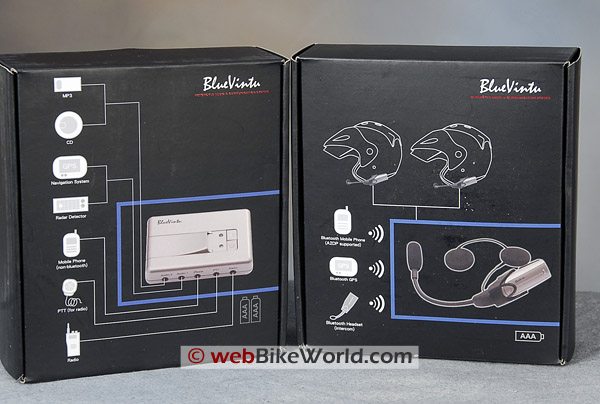
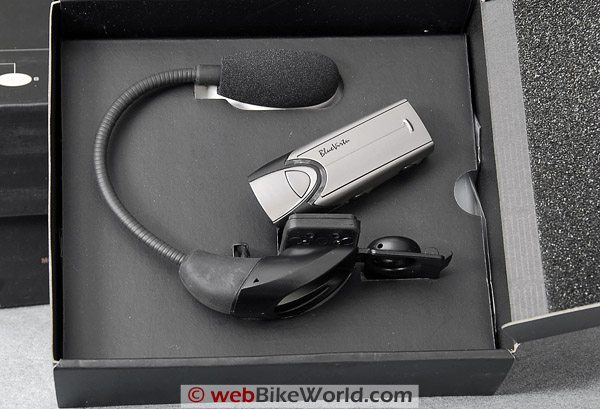
Where to Buy BluVirtu BAT 01 and Bluetooth BSH-01
Check Reviews & Prices on Amazon Check Reviews & Prices On RevZillaSee More: Motorcycle Intercom, Motorcycle Accessories, Motorcycle Helmets
BSH-01 Bluetooth A2DP Headset
Just as enticing as the BAT-01 module, the BSH-01 Bluetooth Headset is a bit more complex. This sophisticated module supports up to three Bluetooth connections, controlled by three buttons. Two of the buttons are located on the facing edge and a larger third button on the top front of the component.
As with similar small multi I/O devices, the three control buttons have a multitude of functions. With the module installed in its chassis, Button A is on the RH side – it is used for powering up and down, initiating pairing mode, volume UP, selecting Device 1 for pairing and, changing to Device 1 for use.
Button B is centered on the face – it provides volume DOWN, selects Device 2 for pairing and changing to Device 2 for use. Button C, located on the left top edge at the front, is used to Start/Stop the Intercom, select Device 3 for pairing and change to Device 3 for use.
Status indicators are provided by the Red & Blue LED set, located behind Button C, and a variety of tones or tonal pairs.
Data connectivity between the headset chassis and the module is via mini-USB. Due to the way the module fits into the chassis, just the right angle is needed to get the USB connection to slide together. Removing it takes a bit of jiggling as well, a firm pull on the back of the module works.
Installing the stereo headset is relatively simple. The headset has its own lead and is connected to the chassis via a flat multi-pin connector. The Arai RX-7 earpieces were scalloped out to accommodate half the thickness of the high-fidelity speakers – providing necessary clearance for the ears. But the next step of the installation did not go quite as smoothly…
The small metal bracket provided in the kit did not work well with any of the Arai units or the Nolan N-102 Flip helmet – is will likely be tenuous at best on many helmets. A light-weight but larger plastic clamp bracket would be much better. The (poorly designed) bracket detracts from what is otherwise a high-quality package.
In the end a field expedient solution had the plastic chassis attached to the lower left side of the helmet with two strategically placed adhesive-backed cable mounting bases and two small tie straps (color coordinated of course). Although not as clean as a single simple bracket mount, the assembly is still very secure, even after a month of use.
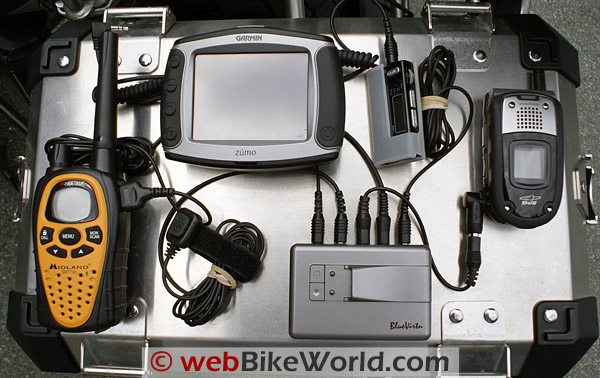
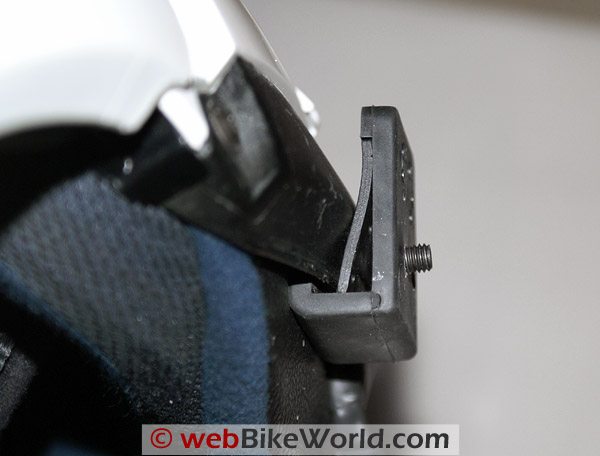
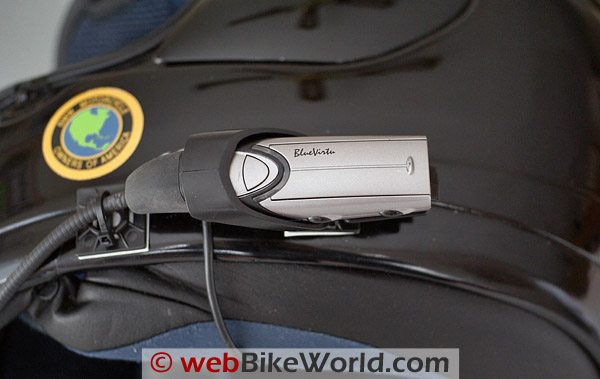
A Note on the “Advanced Audio Distribution Profile” (A2DP)
Advanced Audio Distribution Profile, or A2DP, is becoming a standard feature and for good reason. If one is used to a mono audio stream between Bluetooth devices, A2DP brings about a big change in the listening experience, even if a twin-speaker headset is already used.
While other motorcycle oriented Bluetooth manufacturers are or will be offering this feature, the BluVirtu BSH-01 Bluetooth headset is the first one into the evaluation queue. Streaming audio in stereo between two A2DP profile-compliant devices is simple and the results are well, clearly audible.
A safety issue that arises here concerns the use of a full stereo headset and listening to multi-channel audio inside a helmet…all pros and cons appreciated it is still an issue that must be acknowledged and dealt with by the individual rider – enough said.
BAT-01 and BSH-01 Configuration
The Quick Guide found in each kit contains the information needed to get up and running with minimum delay and considering the simplicity of both kits, most users will never need any more information anyway. Items not addressed are warranty and support, although the main website and international phone numbers are listed.
With two NiMH 900mAh AAA batteries installed in the module and one of the same installed in the headset, it was time to ‘ready, set, go’. Pressing the power button on the BAT-01 causes the Green LED to flash rapidly, which it will do until either paired or it goes into stand-by mode. To power the headset up, press the ‘A’ button for five seconds – the LED will flash Blue.
When used as a complementary set the BAT-01 and BSH-01 are supposed to pair up automatically – they did, in less than five seconds. Once connected, the control module Green LED will flash twice every second indicating an open channel or audio link to the headset. The headset LED will flash a slow and steady Blue.
A manual pairing is almost as simple – press the BAT-01 Pairing Button for 3-5 seconds until the Green and Red LEDs flash and then press the “A” button (Mode A, Device 1) on the headset module for about eight seconds to initiate its pairing mode, indicated by the alternating Red and Blue LEDs. Most pairings will take place within five to 15 seconds.
Where to Buy BluVirtu BAT 01 and Bluetooth BSH-01
Check Reviews & Prices on Amazon Check Reviews & Prices On RevZillaSee More: Motorcycle Intercom, Motorcycle Accessories, Motorcycle Helmets
Basic Functions and Indicators
The BAT-01 is extremely simple and outside of making sure the connections are good and that there is power, it doesn’t require much attention.
As the setup for the headset was not totally clear some familiarization was done to validate the key processes. In essence, the steps are: Power On/Off – hold A button five seconds – Blue LED will flash; resetting the headset – with headset off, press both A and B buttons for eight seconds, Blue and Red LEDs will flash together, then turn off headset via A button.
For Pairing Mode, press A for 8 to 11 seconds – Blue and Red LEDs will flash; for Device Pairing Selection – when in pairing mode, push A, B or C to select the desired assignment (device 1, 2 or 3) to be given to the target device – when A, B or C is pushed, the headset will respond with either 1, 2 or 3 beeps, confirming the device assignment selected.
Pairing Completed – both the host headset and the target device will revert back to a steady blue or double-blue flashing mode, indicating that a link has been made.
Peripheral Device Compatibility
As configured for the evaluation, the BAT-01 successfully supported a number of peripherals: the Midland FRS/GMRS GXT735 radio, with the VOX setting off and the PTT switch used; a Radio Shack Portable CB Transceiver using the PTT switch; a standard non-Bluetooth mobile phone; and, three different portable MP3 players.
The module has no amplification or automatic volume control (AVC) capability so it is necessary on two counts to adjust individual device volumes to efficient levels – so that clear audio is heard in the helmet and, to maintain a minimum input level to the BAT-01. If input from any device stops or falls too low, the BAT-01 will close that port.
Moving from mono to stereo, it was time to get the A2DP device paired up with the headset. With the BAT-01 module already configured via Mode A as Device 1 (using the A button during setup), the Quick Guide recommended configuration was followed to add the Bluetooth enabled PDA device to the mix via Mode A as Device 2 using the B button.
The PDA found the Multi-HS device after two passes and with the pass-code entered the partnership was secured and established. The PDA device presents both ‘hands free’ and ‘wireless stereo’ feature boxes – both are enabled (checked) and the partnership saved off.
With a favorite tune selected from the PDA’s 4GB micro-SD card, the helmet immediately fills with stereo audio, including a hint of bass – how sweet it is!
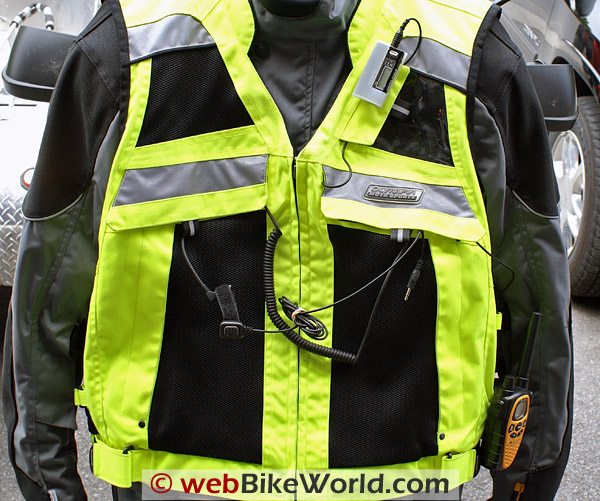
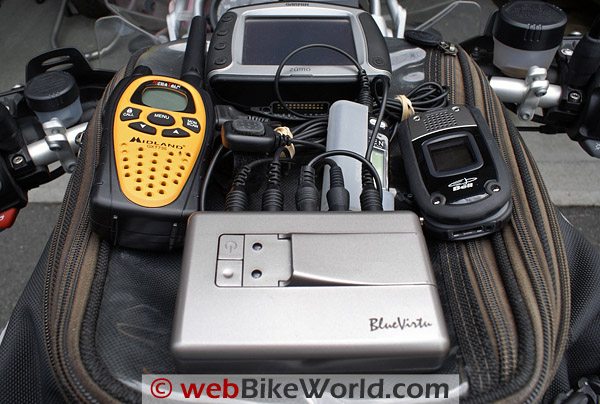
Road Warrior Review
With the radio device connected and the PTT switch mounted on the left handlebar grip, the GPS audio output is connected to Audio 1 while the MP3 player/FM tuner is connected via Audio 2. The mobile phone is connected via Bluetooth to the headset to provide the A2DP feature.
When using the BSH-01 headset and the BAT-01 together, the host headset provides the priority audio management while the BAT-01 manages the peripherals directly connected to it by wire. The priority of all ‘connected’ devices can be varied depending on the device and port configuration.
The recommended combination, based on using three connections, is to configure the BAT-01 as Device 1 on Button A, a mobile phone as Device 2 on Button B, and the Intercom as Device 3 on Button C (required). If the BAT-01 is not used all the time, the configuration can be left with only Button B and Button C used.
The radio sessions conducted with the portable CB units proved that the BAT-01 module senses and switches very quickly (probably in the order of 250 to 300ms). This is a tolerable delay for systems that do not have audio buffering, a feature typically found in more expensive systems. Keying the PTT switch and waiting that short period before speaking will ensure that nothing is lost in the transmission.
If a portable CB transceiver is going to be used as the primary radio device, especially for longer trips, a larger antenna is recommended. This is something that can be readily fitted at the rear of most motorcycles. This type of antenna will greatly improve range, as the short flexible antenna is good for short distances only.
The headset itself is a great component with hi-fi sound available at the push of a button. Switching between a mono audio feed to the stereo stream from the PDA device is like night and day, even at speed on the highway. Between the enhanced audio in the helmet and a really good volume range from the BSH-01, outside noise was not an issue, even with the de rigueur earplugs.
Where to Buy BluVirtu BAT 01 and Bluetooth BSH-01
Check Reviews & Prices on Amazon Check Reviews & Prices On RevZillaSee More: Motorcycle Intercom, Motorcycle Accessories, Motorcycle Helmets
BSH-01 Intercom Limitations
As a low-power device, the BSH-01 Bluetooth headset is not meant to be used as a dedicated rider to rider communications, but is more suited for intercom use. Establishing a pairing between two units for intercom use is a bit different than the standard pairing.
With the first headset, hold the A button in for 11 to 12 seconds – the Red and Blue LEDs will flash quickly (vice the slower alternating flashes when in standard pairing mode) and then push the C button (three beeps should be heard). Now hold the A button on the second headset for eight seconds to put it in the standard pairing mode and push its C button (three beeps will be heard.
Within two or three seconds both units will beep and revert to a slowly flashing Blue LED indicating a successful intercom link. While an intercom link will be made, the link will be dropped very quickly unless the conversation is a continuing one. And if the link drops, any other priority audio is resumed immediately.
The intercom capability is very weak – after numerous attempts to use it in both a static and riding environment, the verdict pretty much wrote itself – it needs work..
BAT-01 Compatibility
To assess compatibility of the BAT-01 module with other Bluetooth headsets, both the current favourite, the scala-rider Q2 (review) and the Cellular Interphone (review) systems were tested. The scala-rider Q2 Bluetooth headset paired up in less than five seconds, with audio transferred and basic phone functionality enabled.
Surprisingly however, the older but typically tried and true Interphone unit absolutely refuses to cooperate. Charging batteries, attempting new initializations by the validated procedures, along with one usually expedient workaround didn’t do the trick either. It does work – the distributor is running this configuration…failure is not an option – troubleshooting is ongoing.
The Tech Sessions
Basic setup for initial pairing between BAT-01 and BSH-01:
BAT-01 off, power is turned on, and pairing button held down for about 5 seconds to initiate pairing mode indicated by both Green and Red LEDs flashing in sequence. Pairing between the two devices will usually only take about five to ten seconds, then the Green LED on the BAT-01 will flash twice a second indicating an open audio link, while the BSH-01 will flash a slow and steady Blue LED.
Any peripherals plugged into the BAT-01 will now be active in the headset via the Bluetooth link. There is no AVC, so volume settings must be adjusted on the individual devices – if the volume is set too low and approaches any noise level, the link will be dropped, usually because the BAT-01 processor is figuring out if a higher priority device is active. In any case, the active device will be restored in a few seconds.
The Best Combination Configuration Sessions
Before the next pairings were done, the BSH-01 headset was re-set to clear all previous settings and pairings. To do this, hold both A and B buttons down together – after about eight seconds both LEDS will flash, once this happens, turn the unit off using the A button. The system is now reset.
- Mode A, Device 1 setup: Per initial setup actions detailed above.
- Mode A, Device 2 setup: BAT-01 off, hold A button down until pairing mode is enabled, then push Button B (for Mode A Device 2), a double beep will be heard. At the same time, enable the pairing mode on the second device, in this case the PDA device. Within ten seconds the headset module was detected by the PDA, and once the pass-code was entered, the partnership was secured and activated with audio transferred to the headset, in stereo.To switch between the two devices, simply hold A or B down for about five seconds and that device will become the active Bluetooth connection. The only issue was that the PDA kept defaulting to the phone mode when switching between the two devices – the BAT-01 and the PDA. When the PDA was switched out, the device automatically pauses the media player so that the battery is not run down. When one of the connected devices is shut off or paused, the headset module will switch back to the active device within ten seconds.
- Mode B, Device 3 setup – GPS: Before attempting the Intercom setup, a third device was added to the headset, a Garmin zumo550 GPS. Turn the BSH-01 off and then back on putting it in pairing mode using Button A. Then initiate the add Bluetooth device on the zumo550 menu – it will make one or two passes at a minimum before finding the headset.Once accepted (no pass-code was requested), and the audio/MP3 setting selected, audio will be heard in the headset. Although this was set up as Mode B Device 3 (priority 3), the headset kept defaulting to this device, switching to device A or device B would work for a few seconds, then the headset would beep three times and switch back to device C – if the audio stream from this device was stopped, the next priority device would be activated, or sometimes the priority one device – it was a bit of hit and miss on occasion.
- Mode B, Device 3 setup – Intercom Function: Both BSH-01 headsets turned off. One headset is turned on and by holding Button A down for an extended count of 11-12 seconds, the Red and Blue LEDs will be in fast flash mode.Next press the C button – three beeps will be heard in the headset. Put the second BSH-01 into standard pairing mode by hold Button A for about 8 seconds (Blue and Red LEDs flashing slowly), then press its Button C – three beeps will be heard and within a couple of seconds, the two headsets will pair up, with three beeps being heard in each headset.The intercom function was pretty weak – one headset worked well – good audio in and good output, but reception in the second helmet was very poor – very noisy and very low volume. Re-setting and/or re-pairing did not help in any way.
Switching between all three devices is accomplished by hold the desired device button down for 5-6 seconds – after a couple of seconds or so, the audio link to that device will be restored. If any device is turned off or the stream stopped, the headset will default back to the previously active device, based on the setup priority. Occasionally however the headset would default back to the Priority 1/Device 1 instead.
Conclusion
The BAT-01 is a great little package. Totally portable and very transportable it is small enough to stash anywhere. The module and three connecting cables all fit easily into one upper cargo pocket of an Olympia riding vest, with the MP3 player clipped to the outside of the pocket and the radio to the side adjustment strap.
As a Bluetooth headset the BSH-01 headset is not perfect, but it is a real step forward and not just because it supports A2DP. Fixing the weak intercom and enabling it for true rider to rider functionality would really move this headset forward when compared with other offerings.
Always of concern with truly portable devices, battery life on both components has been very good. The BAT-01 typically cranks along for close to 15 – 18 hrs before the two AAA batteries need recharging. BSH-01 battery life varies somewhat depending on type of use – typically it will run 6 – 7 hours on one charge, with consistent audio streaming, including music.
While not without some issues, both devices represent the direction being taken by industry in providing more and more choice to motorcyclists who want to both ride, and communicate.
Where to Buy Blu Virtu Motorcycle Communication System
Check Reviews & Prices on Amazon Check Reviews & Prices On RevZillaSee More: Motorcycle Intercom, Motorcycle Accessories, Motorcycle Helmets
Owner Comments and Feedback
See details on submitting comments.
From “C.C.” (8/08): “Couple questions. If the BSH-01 is used without the BAT-01 can channel A be a Bluetooth GPS, channel B a cell phone or is channel A always reserved for the BAT-01? If you aren’t going to use the channel C as an intercom can you put a third miscellaneous Bluetooth device on that channel or does it always have to be reserved for the intercom?”
HBC’s Reply: Two good questions. I went back and reviewed the original article, my work notes here, and some updated information from the new www.bluevirtu.com website (see the motorcycle device pages).
In essence, if the BAT-01 is not used, Channel A can be paired with something else, which is the way I have been using the headset. Both A and B can be set up and used with a number of devices, you just have to be cognizant of the programmed switching priority. So, channel A is not ‘reserved’ per se.
Channel C or Device 3 is a different matter. If you review the ‘Best Combination Configuration Sessions’ section at the end of the article, you will see the various combinations tried…including using Channel C or Device 3 for something other than the Intercom.
It became evident that a third device, i.e., zumo 550, could be paired, but even appreciating the ‘programmed’ system priority of Device 1, 2 and then 3, the module kept defaulting or switching from A or B back to C, even when the other devices were active – a bit annoying.
Based on the instructions and in having just tried this again this evening, I would keep Channel C or Device 3 as the Intercom, and use A and B for active devices or inputs. I think this configuration would provide a stable environment.
Having said this and for what its worth, the information posted on the Blue Virtu site is much better written and reflects some changes from the procedures identified in the supplied manual, etc…there may have been a couple of changes to the system, probably firmware, but whether this as impacted how the overall system can be used is unknown.”
From “M.S.”: “Can you plug any standard stereo head phone set into the unit? In other words, I want to use a set that wraps around the back of the head that will work with a half size helmet, rather than individual ear pieces over each ear.”
HBC’s Reply: Neither the BAT-01 control module or the BSH-01 Bluetooth Headset can support a stereo head set nor any device that requires a plug. The BAT-01 only supports wireless peripherals, not a wired headset of any type, other than the Bluetooth mono connection to a Bluetooth headset, like the BSH-01.
In this situation, with a shortie or half-size helmet, a viable option (that I have not yet attempted), might be to use a third-party Bluetooth headset (mono or stereo) such as are used by many to link with a Bluetooth mobile phone, and which typically fit over the individual ear, or have a neck wrap of some sort…if a pairing can be done between the BAT-01 and this Bluetooth device, then a solution of sorts might be possible.
Also From “M.S.”: “I just read your review on the BluVirtu BAT 01 and Bluetooth BSH-01 Communication System. My questions is, will the BSH 01 work with a half size or shortie helmet?”
HBC’s Reply: As long as the BSH-01 can be fitted onto the helmet edge somehow, and the boom microphone is long enough, it should work. The boom itself is five inches long, and the microphone unit is another two, providing seven inches of extension from the module itself. The headset might be another issue, but as long the helmet covers the ears, it should install OK – anything less will not provide a spot to mount the headset, unless it were to be mounted on a thin-wire frame, like portable headsets.







No Comment